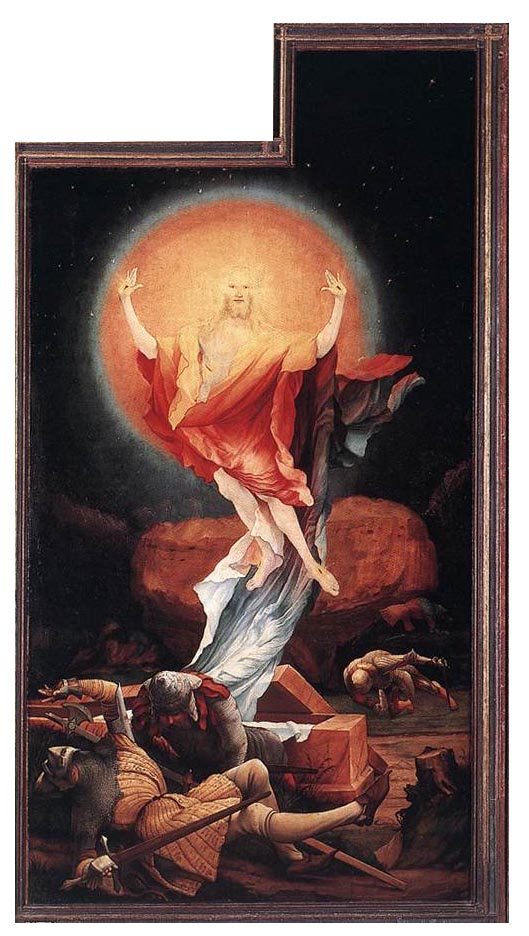
ST. LOUIS (BP)–The year 1515 brought new responsibilities to a young German monk named Martin Luther. He became the overseer of 11 monasteries, and began lecturing on the book of Romans. Luther knew God demanded righteousness, and he tried with all his might to be a good monk. However, in studying Romans he awoke to see the righteousness demanded by God is a righteousness provided by God, the imputed righteousness of Christ. Luther said, “What does avail is God’s imputation of righteousness for Christ’s sake, through faith.” Luther found the Gospel and the Gospel found him. Less than two years later, Luther sparked the Protestant Reformation by nailing his 95 Theses to the church doors at Wittenburg.
 Meanwhile, around the same time in another German monastery, Matthias Grünewald began to paint what is considered his greatest work, the “Isenheim Altarpiece” — a series of paintings of Christ that make up one masterpiece. One element of that altarpiece is “Resurrection,” which is shown on this page.
Meanwhile, around the same time in another German monastery, Matthias Grünewald began to paint what is considered his greatest work, the “Isenheim Altarpiece” — a series of paintings of Christ that make up one masterpiece. One element of that altarpiece is “Resurrection,” which is shown on this page.
Throughout Western civilization, there have been hundreds of masterworks depicting the resurrection of Jesus. What makes Grünewald’s “Resurrection” so special? What stands out?
The most significant feature is the enormous sun behind the risen Christ. The sun seems to blend right into the top of his head. Stars remain visible in the dark background, for this is the sun of early dawn (Luke 24:1).
Symbolizing Christ as light and sun is directly from the Bible. Jesus said, “I am the light of the world” (John 8:12). In a messianic prophecy, Malachi 4:2 says, “But for you who fear my name, the sun of righteousness shall rise with healing in its wings.”
The luminous light of Christ’s dawn overcomes the nighttime bleakness. “The light shines in the darkness, and the darkness has not overcome it” (John 1:5). The light of Christ also brings life through the Savior, “In him was life, and the life was the light of men” (John 1:4).
And it is God Himself who brings the light to our darkened hearts. “For God, who said, ‘Let light shine out of darkness,’ has shone in our hearts to give the light of the knowledge of the glory of God in the face of Jesus Christ” (2 Corinthians 4:6).
Jesus of Nazareth claimed to be God. The religious leaders cried, “Blasphemy!”, and sought to kill him. If what Jesus claimed about himself was false, then his dead body would forever remain in the tomb. The dusty bones of another false messiah would exonerate the religious leaders for their hatred of Jesus.
But Jesus was no false messiah. God the Father directed the earth to spin through space, and once again the sun rose on the horizon. And in an even greater display of God’s power, the Son also rose on the horizon. God would not allow Jesus to remain and rot in the tomb (Psalm 16:10).
Look again at the painting, and note the color of Christ’s clothing. Observe the difference in color as your eye moves from grave to sky. Coming out of the ground the cloth is grayish-white with a tinge of blue. These colors are symbolic of mourning and humility. From borrowed manger to borrowed tomb, Jesus lived as a “man of sorrows” among those who “esteemed him not”.
However, from the moment of the resurrection, Jesus was and is forever in a position of exaltation (Philippians 2:9-11). Hence, the color of the mantle surrounding him at the top is bright yellowish-red. Yellow is the color of divinity and sovereign power. Because of the resurrection, Jesus was transformed from the humble and suffering servant into the honored and sovereign savior.
But there is more. Look at the nail prints in the hands and feet of Jesus. Remember how Thomas had doubted that Jesus was alive, saying he would only believe when he saw the nail prints in the hands (John 20:25-27). Christians will one day see Christ face to face, and on that day we too will see the nail prints in his hands and feet (Revelation 5:12). Do you believe this? Does your mind think of Jesus in literal, historical flesh-and-blood terms -– a real man who had real iron nails pushed through skin and sinew? Do you believe? “If you confess with your mouth that Jesus is Lord and believe in your heart that God raised him from the dead, you will be saved” (Romans 10:9).
While it is humorous to see 16th century European soldier’s clothes and a German-style gravesite, don’t miss the point. Look at the utter impotence of the powers at work against Christ. The heavy stone plate on the sepulcher is thrown open. The soldiers are sleeping, falling over and knocked out. Matthew 28:4 says of the guards, “And for fear of him the guards trembled and became like dead men.”
But it is not just the Romans and the Jews who were impotent in the face of resurrection power, for even gravity does not hold down Christ! Perhaps this is a foreshadowing of the ascension, or a symbolic display of his “being over all” (Ephesians 1:22). Most importantly, death itself held no power over Jesus. “Death is swallowed up in victory. O death, where is your victory? O death, where is your sting? The sting of death is sin, and the power of sin is the law. But thanks be to God, who gives us the victory through our Lord Jesus Christ” (1 Corinthians 15:54-57).
Which brings us back full circle to Martin Luther. In 1515, even as Grünewald was painting his Resurrection, Luther penned the following words: “The content of the Gospel is Jesus Christ, the Son of God, born of the seed of David, according to the flesh, and now appointed to be King and Lord of all things with power, and this according to the Holy Ghost who raised Him from the dead.”
But whatever happened to Grünewald? He was not even correctly identified by historians — his name actually was Mathis Gothart. Historians, though, sometimes make mistakes. Some people thought Grünewald’s paintings were created by the great German artist Albrecht Dürer. What we do know is that Grünewald eventually chose to live in German cities that supported the Protestant Reformation. And when he died, his possessions included some of Luther’s printed sermons. Grünewald painted a crucified and risen Christ, but did he find salvation for his own soul through the living Christ? More importantly, have you?
–30–
Scott Lamb is pastor of Providence Baptist Church in St. Louis, Missouri.

















